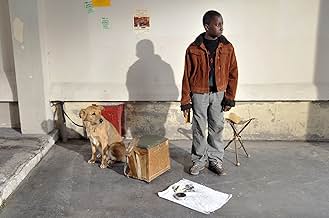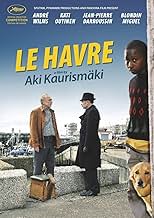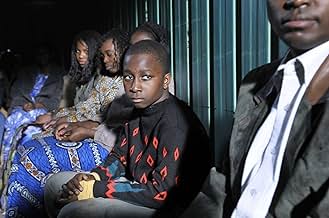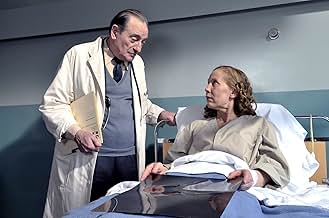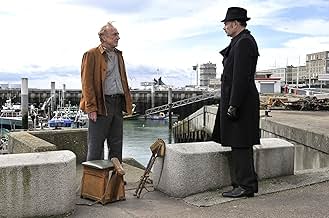AVALIAÇÃO DA IMDb
7,2/10
25 mil
SUA AVALIAÇÃO
Quando um menino africano chega de navio cargueiro à cidade portuária de Le Havre, um engraxate idoso fica com pena da criança e a recebe em sua casa.Quando um menino africano chega de navio cargueiro à cidade portuária de Le Havre, um engraxate idoso fica com pena da criança e a recebe em sua casa.Quando um menino africano chega de navio cargueiro à cidade portuária de Le Havre, um engraxate idoso fica com pena da criança e a recebe em sua casa.
- Direção
- Roteirista
- Artistas
- Prêmios
- 15 vitórias e 34 indicações no total
Quoc Dung Nguyen
- Chang
- (as Quoc-Dung Nguyen)
Little Bob
- Little Bob
- (as Roberto Piazza)
Avaliações em destaque
Like every fairy-tale, this film by Aki Kaurismaki is unbelievable, but this apparent fake doesn't hide a sad reality behind the good intentions of the simple people that help the illegal immigrant child to arrive finally to London, wherein we couldn't predict what kind of life waits for him. A slow rhythm, (some scenes seem like stills), and a brilliant and strong color that contribute to the atmosphere of unreality, the frustration to the normal expectations of the viewers that are carried to imagine the worst, and receive on the contrary the sudden impact of the best, don't prevent to bring to the conscience the images of the cruel world that surrounds the miracle of solidarity that saves, perhaps momentarily, just one of the hundred persecuted. The bad and the good boys are generally discovered by the camera, which leaves, significantly, in off the figure of the pitiless chief of policy, and introduces in darkness the figure of the denouncer. Le Havre is an optimist movie with a very dubious happy end.
Great. Very stylistic in its cinematography and lighting. Condensed and to the bone in its storytelling and editing.
Nice and subtle humour on the background of a highly contemporary story about our unbalanced globe, the hope for freedom and the power of human compassion.
I Truly enjoyed watching a film in which every scene is so carefully and skillfully arranged. This is Kaurismäki at his best working with a great cast and a script stripped of any unnecessary dialogue. The colors and the settings are stunning. There's always a risk that movies like this would come across as to polished or constructed, but from my point of view Kaurismäki strikes a great balance and makes sure that every image adds layers and details to the story.
Nice and subtle humour on the background of a highly contemporary story about our unbalanced globe, the hope for freedom and the power of human compassion.
I Truly enjoyed watching a film in which every scene is so carefully and skillfully arranged. This is Kaurismäki at his best working with a great cast and a script stripped of any unnecessary dialogue. The colors and the settings are stunning. There's always a risk that movies like this would come across as to polished or constructed, but from my point of view Kaurismäki strikes a great balance and makes sure that every image adds layers and details to the story.
In 1992, Finnish director Aki Kaurismaki directed LA VIE DE BOHEME, where he transplanted to Paris for a story of impoverished, failed artists on the cusp of society. A funny, sad film about art, love, and loss. Nearly twenty years later, Kaurismaki returns to France in LE HAVRE; while some of the humor remains, its story of the impoverished and dispossessed is even more affecting.
LA VIE... showed a painterly visual sense, all the more amazing that it was filmed in black and white. LE HAVRE boasts an equally striking visual sense, with scenes that seem to glow. That said, other elements of the production are less convincing - and at times. almost embarrassing. (For example, a group of black refugees are locked in a container crate for almost a week; when it's opened, no one's hungry or even concerned, and several are freshly shaved.)
LE HAVRE sets up the camera in a stationary spot - much like an old silent - giving the film a real resonance. But this affection for older filmmaking will be familiar for Kaurismaki fans; his silent, black and white JUHA uses the same minimalistic approach, with good results.
If you're willing to forgive certain production details and the dependence on melodrama, LE HAVRE is a feel-good story of how those of modest means can help those in desperate straits. (LE HAVRE itself was directed under low budget.) The film's humanism is its saving grace. While the filmmaking is occasionally awkward, there's still a lot to be admired here.
LA VIE... showed a painterly visual sense, all the more amazing that it was filmed in black and white. LE HAVRE boasts an equally striking visual sense, with scenes that seem to glow. That said, other elements of the production are less convincing - and at times. almost embarrassing. (For example, a group of black refugees are locked in a container crate for almost a week; when it's opened, no one's hungry or even concerned, and several are freshly shaved.)
LE HAVRE sets up the camera in a stationary spot - much like an old silent - giving the film a real resonance. But this affection for older filmmaking will be familiar for Kaurismaki fans; his silent, black and white JUHA uses the same minimalistic approach, with good results.
If you're willing to forgive certain production details and the dependence on melodrama, LE HAVRE is a feel-good story of how those of modest means can help those in desperate straits. (LE HAVRE itself was directed under low budget.) The film's humanism is its saving grace. While the filmmaking is occasionally awkward, there's still a lot to be admired here.
The natural flowing of this simple movie, where no excesses are to be noticed ,may make one judge it as a weird movie, where something actually happens, but does seem to affect the lives of the characters. This is not properly true. Indeed, this is a simple movie, with no plot twists, no complications, but here does it lie its magic. It's a movie where "normal", common people simply accept their lives for what they are, which does not mean in a passive way, on the contrary they prove morally resilient people, who relate one another in an authentic way, behave as honest and fair people (so difficult to find people like these nowadays, that they look so strange!) they face bad things with dignity, and good things with no easy enthusiasm. Its best quality lies in the perfect and never clashing blend between hard facts (the hardships of immigrants, the theme of illness) and poetry, with a human faith in miracles which never sounds ridiculous or mystical: miracles happen simply because sometimes they may happen, and there's not even much to wonder at. There's such a placid attitude shown by the characters, very well interpreted by a good cast, that if the aim was to convey a calm and resilient acceptance of life, with its weird mixture of hardness and poetry, well, the aim has been successfully accomplished.
This is a sweet, lightly intoxicating thing like a small glass of calvados under the wisteria in the evening. Kaurismaki has aged and his outcast and misfit characters aged with him, the quirks mellowed, the ferocious smoking toned down, the lines in the sometimes quietly astonished stone faces deeper, wearier, but imbued with almost ascetic serenity.
Some viewers have complained, why trivialize an actual problem in the manner of a fairy tale? A fair complaint for a problem perhaps more pressing than ever, especially in France and especially these days, with Sarkozi's desperate attempt to shore up votes for what looks like near-certain defeat in the upcoming elections by reverting to reactionary rhetorics from the far-right.
No, I believe the fairy-tale is the point. The idyllic neighborhood. The mannered caricatures of French people, with even the poorest having the time and fine sense of taste to leisurely enjoy their freshly baked baguette or glass of wine. The miraculous turn of events, explicitly acknowledged in the finale where kindness of this world is so overwhelming it even cures sickness. How could anyone miss this?
But a certain emptiness has always been of the essence for Kaurismaki, deliberate, designed emptiness.
The world is always flat to that effect, two-dimensional. The characters lack any conventional depth to speak of and do not really grow or learn lessons. By contrast, the plots of the films often exhibit a life of spontaneous motion, the objectives intentionally abstract, journeys across town, to America, in search of coffee and cigarettes. Motion for the sheer musical capacity of life to fill the quiet, the room in the heart to do so.
So it is always a variation of transient worlds centered in the stillness of the present moment that Kaurismaki has studied and consistently delivered. What is so remarkable is that he achieves this without any layering whatsoever, as a single flow.
This is his most Japanese film to date, even more concentrated flow than usual. Which is to say artificial nature that does not attempt to pass for the real thing but instead is empty space cultivated for beauty, a road-map for inner heart.
(I saw this together with the recent viral video KONY2012 and the contrast was amazing: that one, shameless artifice passing as nature, as truth, the real thing, contriving to motivate awareness several years after the fact and by selling merchandise, but was in truth both misinformed and morally dubious and even perhaps unwittingly manipulated agitprop in the service of shady foreign policy, while this one is simple, crisp, gracefully moral work, that does create awareness without any agendas.)
So it is very much the point that no one in the film is shown to wallow in misery, and most of the characters we meet would have plenty of reason to do so. Instead they enjoy this drink or meal together, whatever is at hand. And act with no complaint in the present moment to do what needs to be done. There is no meddlesome thought or proud ego to cloud the mind from the day's work, be it polishing shoes or helping out an immigrant kid.
This is the beauty of the thing: an idyll embedded with the purity of soul that gives rise to it and clear images only possible because of this cloudless eye.
The parting image is of a blossomed cherry tree gently rocking in the breeze, among the most traditionally Japanese images.
It encapsulates motion in stillness. The song of Zen.
Some viewers have complained, why trivialize an actual problem in the manner of a fairy tale? A fair complaint for a problem perhaps more pressing than ever, especially in France and especially these days, with Sarkozi's desperate attempt to shore up votes for what looks like near-certain defeat in the upcoming elections by reverting to reactionary rhetorics from the far-right.
No, I believe the fairy-tale is the point. The idyllic neighborhood. The mannered caricatures of French people, with even the poorest having the time and fine sense of taste to leisurely enjoy their freshly baked baguette or glass of wine. The miraculous turn of events, explicitly acknowledged in the finale where kindness of this world is so overwhelming it even cures sickness. How could anyone miss this?
But a certain emptiness has always been of the essence for Kaurismaki, deliberate, designed emptiness.
The world is always flat to that effect, two-dimensional. The characters lack any conventional depth to speak of and do not really grow or learn lessons. By contrast, the plots of the films often exhibit a life of spontaneous motion, the objectives intentionally abstract, journeys across town, to America, in search of coffee and cigarettes. Motion for the sheer musical capacity of life to fill the quiet, the room in the heart to do so.
So it is always a variation of transient worlds centered in the stillness of the present moment that Kaurismaki has studied and consistently delivered. What is so remarkable is that he achieves this without any layering whatsoever, as a single flow.
This is his most Japanese film to date, even more concentrated flow than usual. Which is to say artificial nature that does not attempt to pass for the real thing but instead is empty space cultivated for beauty, a road-map for inner heart.
(I saw this together with the recent viral video KONY2012 and the contrast was amazing: that one, shameless artifice passing as nature, as truth, the real thing, contriving to motivate awareness several years after the fact and by selling merchandise, but was in truth both misinformed and morally dubious and even perhaps unwittingly manipulated agitprop in the service of shady foreign policy, while this one is simple, crisp, gracefully moral work, that does create awareness without any agendas.)
So it is very much the point that no one in the film is shown to wallow in misery, and most of the characters we meet would have plenty of reason to do so. Instead they enjoy this drink or meal together, whatever is at hand. And act with no complaint in the present moment to do what needs to be done. There is no meddlesome thought or proud ego to cloud the mind from the day's work, be it polishing shoes or helping out an immigrant kid.
This is the beauty of the thing: an idyll embedded with the purity of soul that gives rise to it and clear images only possible because of this cloudless eye.
The parting image is of a blossomed cherry tree gently rocking in the breeze, among the most traditionally Japanese images.
It encapsulates motion in stillness. The song of Zen.
Você sabia?
- CuriosidadesThe character Marcel Marx, played by André Wilms, first appears in A Vida da Boêmia (1992). Jean-Pierre Léaud also appears in both films, but as different characters.
- Citações
Marcel Marx: L'argent circule au crepuscule.
- ConexõesFeatured in At the Movies: Cannes Film Festival 2011 (2011)
- Trilhas sonorasMatelot
Performed by The Renegades
Principais escolhas
Faça login para avaliar e ver a lista de recomendações personalizadas
- How long is Le Havre?Fornecido pela Alexa
Detalhes
Bilheteria
- Orçamento
- € 3.850.000 (estimativa)
- Faturamento bruto nos EUA e Canadá
- US$ 611.709
- Fim de semana de estreia nos EUA e Canadá
- US$ 26.363
- 23 de out. de 2011
- Faturamento bruto mundial
- US$ 12.959.706
- Tempo de duração
- 1 h 33 min(93 min)
- Cor
- Proporção
- 1.85 : 1
Contribua para esta página
Sugerir uma alteração ou adicionar conteúdo ausente


